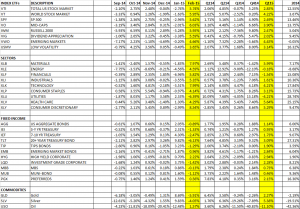Falling oil prices have held the market back of late. Worries are that if oil prices continue to fall, there will be a major hit to earnings but also a serious threat of defaults in the high yield markets. The market doesn’t want high oil prices, but they also don’t want much lower prices. Probably, a steady price somewhat higher than what we currently have would be ideal.
In any case, the futures markets might be giving us a hint that the bottom in oil is somewhat near. A market is in “contango” when the futures price is greater than the spot price. As the futures contract comes close to ending, the futures price and the spot price have to converge. A market that is in “contango” has traders essentially betting that the spot price will rise, otherwise their speculation will end in a loss.
Per a report provided by Ned Davis Research, the market as measured by the 5-year futures contract over the 91-day perpetual contract is at an extreme. Less than 2008 but on par with 1998. Such an extreme came close to marking the bottom in those years. In 2008, oil fell 79% and in 1998 it fell 59%. Currently, oil is down 60%.
However, buying oil-related stocks based on a bottom in the price is usually best a few months after the bottom is in.

